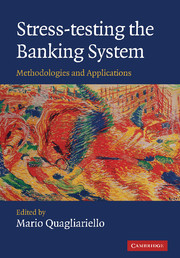Book contents
- Frontmatter
- Contents
- List of figures
- List of tables
- List of boxes
- List of contributors
- Foreword
- Acknowledgements
- Introduction
- Part I Fundamentals
- Part II Applications
- 8 Stress-testing credit risk: the Italian experience
- 9 Stress-testing US banks using economic-value-of-equity (EVE) models
- 10 A framework for integrating different risks: the interaction between credit and interest rate risk
- 11 Stress-testing linkages between banks in the Netherlands
- 12 An integrated approach to stress-testing: the Austrian Systemic Risk Monitor (SRM)
- 13 From macro to micro: the French experience on credit risk stress-testing
- 14 Stress-testing in the EU new member states
- 15 Cross-border macro stress-testing: progress and future challenges for the EU
- 16 Stress-testing at the IMF
- Conclusions
- Index
- References
10 - A framework for integrating different risks: the interaction between credit and interest rate risk
from Part II - Applications
Published online by Cambridge University Press: 18 December 2009
- Frontmatter
- Contents
- List of figures
- List of tables
- List of boxes
- List of contributors
- Foreword
- Acknowledgements
- Introduction
- Part I Fundamentals
- Part II Applications
- 8 Stress-testing credit risk: the Italian experience
- 9 Stress-testing US banks using economic-value-of-equity (EVE) models
- 10 A framework for integrating different risks: the interaction between credit and interest rate risk
- 11 Stress-testing linkages between banks in the Netherlands
- 12 An integrated approach to stress-testing: the Austrian Systemic Risk Monitor (SRM)
- 13 From macro to micro: the French experience on credit risk stress-testing
- 14 Stress-testing in the EU new member states
- 15 Cross-border macro stress-testing: progress and future challenges for the EU
- 16 Stress-testing at the IMF
- Conclusions
- Index
- References
Summary
Introduction
As described in the previous chapters, credit and interest rate risk are two of the most important sources of risk for commercial banks. According to commercial banks, interest rate risk is a significant source of market risk, and, after credit risk, is the second most important source of risk. The Standard and Loans (S&L) crisis in the US is an example of the significance of interest rate risk. While banks and regulators are aware of the importance of both risks, they tend to manage them separately. However, credit risk and interest rate risk are intrinsically related to each other and not separable. Ignoring this interdependence may potentially have implications for banks' stability during severe downturns.
The separate treatment has been reflected in most stress tests, which have focused on either credit risk or interest rate risk. For example, traditional macroeconomic stress tests aimed to assess the deterioration in banks' asset quality following an adverse macroeconomic shock (see Sorge, 2004 for a survey). Although these have established that credit risk may significantly reduce the profitability of banks and threaten their solvency, they often fail to recognise the interdependence between credit and interest rate risk. To capture this interdependence it is fundamental to take into account the whole balance sheet. For example, following a sharp deterioration in asset quality, a bank subjected to a downgrade may face higher funding costs, which could amplify the losses to the bank.
- Type
- Chapter
- Information
- Stress-testing the Banking SystemMethodologies and Applications, pp. 165 - 183Publisher: Cambridge University PressPrint publication year: 2009

